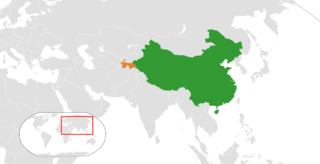
Tajikistan is nestled between Kyrgyzstan and Uzbekistan to the north and west, China to the east, and Afghanistan to the south. Mountains cover 93 percent of Tajikistan's surface area. The two principal ranges, the Pamir Mountains and the Alay Mountains, give rise to many glacier-fed streams and rivers, which have been used to irrigate farmlands since ancient times. Central Asia's other major mountain range, the Tian Shan, skirts northern Tajikistan. Mountainous terrain separates Tajikistan's two population centers, which are in the lowlands of the southern and northern sections of the country. Especially in areas of intensive agricultural and industrial activity, the Soviet Union's natural resource utilization policies left independent Tajikistan with a legacy of environmental problems.
The politics of Tajikistan takes place in a framework of a presidential republic, whereby the President is both head of state and head of government, and of a multi-party system. Legislative power is vested in both the executive branch and the two chambers of parliament.

Since independence, Tajikistan gradually followed the path of transition economy, reforming its economic policies. With foreign revenue precariously dependent upon exports of cotton and aluminium, the economy is highly vulnerable to external shocks. Tajikistan's economy also incorporates a massive black market, primarily focused on the drug trade with Afghanistan, and heroin trafficking in Tajikistan is estimated to be equivalent 30-50% of national GDP as of 2012. In fiscal year (FY) 2000, international assistance remained an essential source of support for rehabilitation programs that reintegrated former civil war combatants into the civilian economy, thus helping keep the peace. International assistance also was necessary to address the second year of severe drought that resulted in a continued shortfall of food production. Tajikistan's economy grew substantially after the war. The gross domestic product (GDP) of Tajikistan expanded at an average rate of 9.6% over the period of 2000-2007 according to the World Bank data. This improved Tajikistan's position among other Central Asian countries, which have degraded economically ever since. As of August 2009, an estimated 60% of Tajikistani citizens live below the poverty line. The 2008 global financial crisis has hit Tajikistan hard, both domestically and internationally. Tajikistan has been hit harder than many countries because it already has a high poverty rate and because many of its citizens depend on remittances from expatriate Tajikistanis.
The spread of telecommunications services in Tajikistan – telephony, radio, television and internet – has not been as extensive as in many other countries.

Foreign relations of Tajikistan are based on a desire to secure foreign investment and promote regional security while ensuring Tajikistan's independence. Sirodjidin Aslov is the current Foreign Minister of Tajikistan.

The Tajik Soviet Socialist Republic, also commonly known as Soviet Tajikistan and Tajik SSR, was one of the constituent republics of the Soviet Union which existed from 1929 to 1991 located in Central Asia.

The national flag of Tajikistan was adopted in November 1992, replacing the flag of the Tajik Soviet Socialist Republic of 1953. The flag of Tajikistan is a horizontal tricolor of red, white and green with a width ratio of 2:3:2, charged with a crown surmounted by an arc of seven stars at the centre.

The Tajikistani Civil War, also known as the Tajik Civil War or the War in Tajikistan, began in May 1992 when regional groups from the Garm and Gorno-Badakhshan regions of Tajikistan rose up against the newly-formed government of President Rahmon Nabiyev, which was dominated by people from the Khujand and Kulyab regions. The rebel groups were led by a combination of liberal democratic reformers and Islamists, who would later organize under the banner of the United Tajik Opposition. The government was supported by Russian border guards.

Human rights in Tajikistan, a country in Central Asia, have become an issue for international concern. The access to basic human rights remains limited, as corruption in the government, leading to the systematic abuse of the human rights of its citizens, slows down the progress of democratic and social reform in the country.

Iran–Tajikistan relations refer to the bilateral relations between Iran and Tajikistan. Since the collapse of the Soviet Union, the two countries have naturally enjoyed a close relationship.

Tajikistan first participated at the Olympic Games as an independent nation in 1996, and has sent athletes to compete in every Summer Olympic Games since then. The nation has also competed at the Winter Olympics since 2002. To date, Andrei Drygin is the only person ever to have represented Tajikistan at the Winter Olympic Games, being his country's sole competitor in 2002, 2006, and 2010.

Pakistan–Tajikistan relations are the foreign relations between Pakistan and Tajikistan.

The jamoats of Tajikistan are the third-level administrative divisions, similar to communes or municipalities, in the Central Asia country of Tajikistan. There are approximately 405 jamoats of Tajikistan. Each jamoat is further subdivided into villages

Visitors to Tajikistan must obtain a visa from one of the Tajikistan diplomatic missions unless they come from one of the visa exempt countries or countries whose citizens are eligible for an electronic visa or a visa on arrival.

China–Tajikistan relations are the bilateral relations between the People's Republic of China and the Republic of Tajikistan, established on January 4, 1992, shortly after the dissolution of the Soviet Union.

Malaysia–Tajikistan relations are foreign relations between Malaysia and Tajikistan. Malaysian embassy in Tashkent, Uzbekistan is also accredited to Tajikistan, while Tajikistan has an embassy in Ampang, Selangor. Both countries have been enjoying warm diplomatic relations and are willing to make constructive efforts towards progress.
The Military ranks of Tajikistan are the military insignia used by the Armed Forces of the Republic of Tajikistan. Being a former member of Soviet Union, Tajikistan shares a rank structure similar to that of Russia. Tajikistan is a landlocked country, and does therefore not possess a navy.












